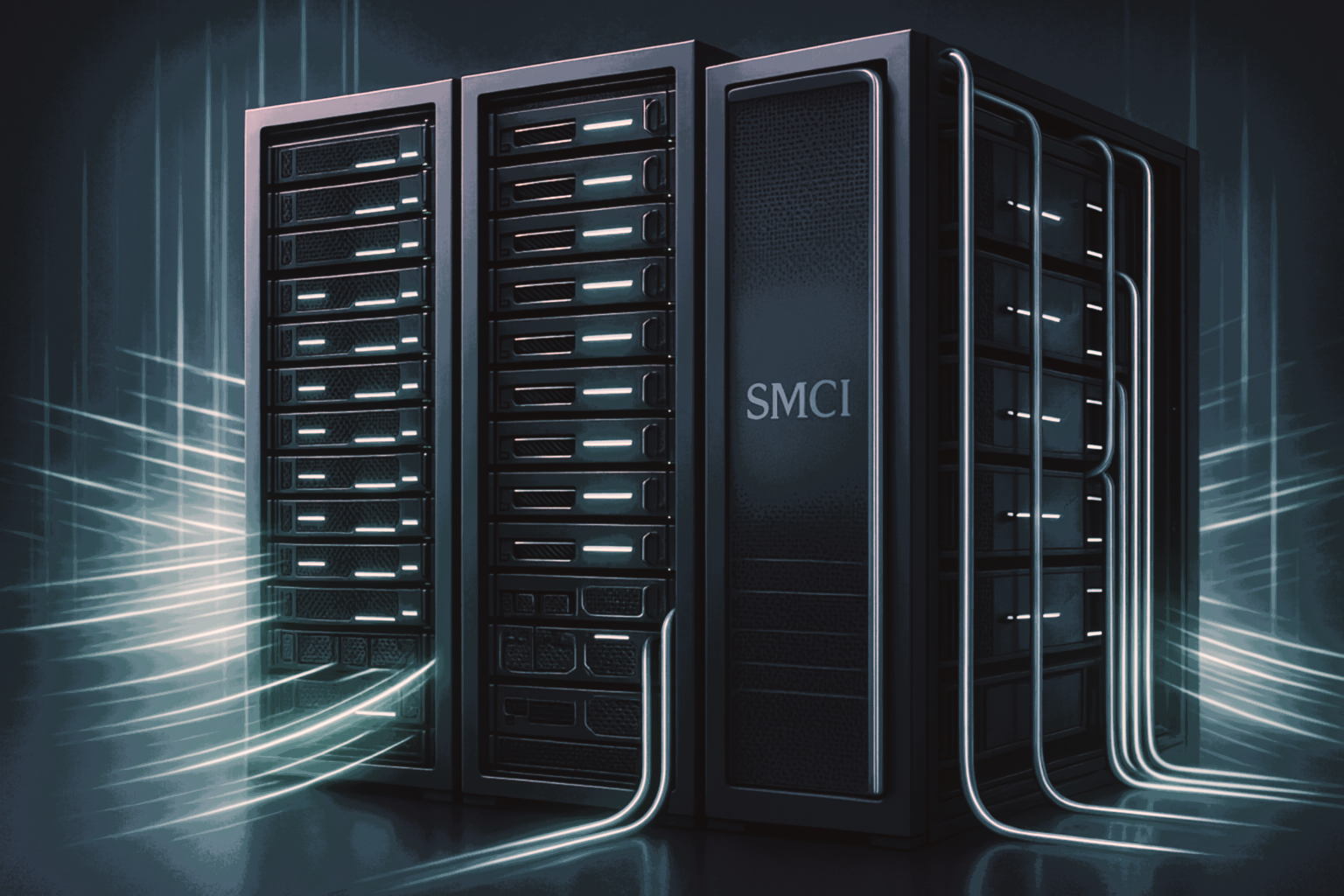What Is SMCI And Why Stock Splits Matter
Company Overview
Super Micro Computer, Inc., basically just SMCI, with its headquarters in San Jose, California, is a company that is at the forefront of high-performance, highest-server technology energy-efficient servers. It opened its doors in 1993 and has been going bonkers, riding on the unique skill of designing scalable data center infrastructure tailored specifically to cloud computing, enterprise IT, and artificial intelligence (AI) workloads. From mid-2025 onward, SMCI will have facilities in the United States, Taiwan, and the Netherlands, catering to a wide client base ranging from Fortune 500 tech giants to research labs and AI startups.

The company’s innovations focus on rack-scale systems, edge platforms, and liquid-cooled GPU clusters, all deployed to entertain data-hungry AI models and HPC-based applications. With a staff strength of over 5,600 worldwide and being an OEM for NVIDIA, Intel, and AMD, Supermicro occupies a distinct position in the AI-driven hardware crafting race. The firm continues to pour heavy investments into green computing and total ownership cost efficiency-the two areas of growing vitality as hyperscalers in the AI economy.
Significance Of Stock Splits In Equity Markets
In the financial markets, stock splits are often viewed as a sign of confidence exhibited by the management and devised with the aim of bringing greater share accessibility. For fast-growing tech companies, which go through steep price appreciation, a split works as a means to maintain a certain level of psychological affordability to the retail investor while simultaneously maintaining the share’s attractiveness to options traders.
From a historical point of view, the firms performing stock splits — especially tech companies — have witnessed increased trading volumes, brand recognizability, and improvements in liquidity measures. Notwithstanding the fact that the splits do not alter the underlying fundamentals of the corporation, the post-split time window generally invites higher media coverage, analyst attention, and speculation-driven flows. It is this phase for traders that opens up a gamut of strategies based on behavioral finance triggers.
Chronology Of SMCI Stock Splits

Early Splits And Share Count Changes
For more than 16 years since its IPO in 2007, Super Micro Computer chose not to change its share structure. Despite becoming a staple within data center solutions, the company stock remained well below the radar in much of the 2010s in terms of volumes traded and quite subdued being compared against cloud-native peers regarding growth.
The 2023 generative AI boom was the catalyst for a meteoric rise in SMCI’s share price, borne out of exploding demand for GPU accelerated computing infrastructure. The resultant spotlight on valuation prompted management to finally consider more accessible capital structures culminating in the infamous 2024 split.
The 2024 10‑for‑1 Split
This 10-for-1 forward split on October 1, 2024, finalizing its first-ever stock split for SMCI, was preceded by an unusual late-2023 to mid-2024 rally that had seen prices mount from $88 in January 2023 to peak above $400 by September 2024. Management stated strong retail demand, option market accessibility, and corporate governance as some of the reasons motivating the stock split.
This move was also well-aligned with broader market patterns: in 2024 alone, 17 S&P 500 companies executed stock splits, often coinciding with generative AI tailwinds. SMCI’s split was widely viewed as a milestone, transforming it from a niche hardware manufacturer to a retail-favorite growth stock.
Key Milestones And Price Checkpoints
-
March 13, 2024: All-time high of $118.81 (pre-split), reflecting peak AI optimism.
-
October 1, 2024: Shares began trading at ~$41.64 post-split.
-
November 2024: Brief consolidation phase saw prices dip to ~$33.
-
March 2025: Recovery fueled by AI chip upgrade cycle.
-
July 17, 2025: SMCI closed at $52.75, up 73% YTD — outpacing the Nasdaq 100 by over 30%.
Market Reaction And Performance Trends
Immediate Post‑Split Volatility
The trading week following the split witnessed a 3.5x jump in daily trading volume, as retail participation surged alongside renewed coverage by major financial outlets. Brokerage platforms like Robinhood and SoFi reported elevated order flows in SMCI, particularly among traders aged 25–40.
Volatility spiked notably — intraday swings of 6–10% became routine, catalyzed by speculative options activity and AI sector rotation. For seasoned traders, this presented a short-term volatility arbitrage opportunity using delta-neutral strategies such as straddles and strangles.
Mid‑Term Price Trajectory
In Q4 2024 and Q1 2025, SMCI consolidated within a broad range of $33–$45, mirroring AI sector ebbs and flows. Earnings beats, record server shipments, and strategic partnerships supported the stock through periods of regulatory scrutiny, including an SEC inquiry related to inventory disclosures. The stock gradually regained momentum, breaking above $50 in early summer 2025.
Technical analysts observed a textbook cup-and-handle pattern forming between February and May 2025, further fueling breakout speculation. RSI readings consistently hovered between 55 and 65, indicating controlled bullish strength without overextension.
Volume And Liquidity Shifts
The post-split period saw SMCI’s average daily volume rise to ~68 million shares, with occasional spikes above 100 million. Bid-ask spreads tightened from 12–15 cents pre-split to under 5 cents in Q2 2025, enhancing execution efficiency. Institutional investors, previously hesitant due to price concentration, began accumulating positions during Q1 pullbacks, as seen in 13F filings.
Trader Strategies Around SMCI Splits
Pre‑Split Positioning Tactics
Astute traders who anticipated the split began scaling into positions around late August 2024, identifying key resistance near $385 as a breakout zone. Many employed calendar spreads and long-dated calls to capture implied volatility expansion ahead of the event.
Data from CBOE indicated a 140% increase in open interest for SMCI options in the two weeks leading up to the split — a sign of growing speculative activity. Some swing traders also paired SMCI with inverse volatility products to hedge macro exposure.
Momentum Plays Post‑Split
Following the split, short-term players utilized VWAP-based entries and 20-day EMA crossovers to ride the post-event trend. The breach of $45 was particularly significant, attracting algos and high-frequency momentum funds. SMCI’s favorable beta against the Nasdaq made it a preferred candidate for leveraged intraday scalps.
Traders also rotated between SMCI and peers like NVDA, AVGO, and AMD, exploiting sector correlation spreads. Multi-leg strategies like call butterflies and ratio spreads were popular for capturing post-split upside within a defined risk window.
Risk Management And Stop‑Loss Guidelines
Given heightened volatility, disciplined traders employed dynamic stop-losses based on ATR (average true range), which hovered around $2.20 in early 2025. Position sizing was adjusted relative to implied volatility, and many leveraged risk calculators to maintain exposure caps below 3% of total portfolio value.
Seasoned traders also monitored dark pool activity and options flow to detect potential institutional selling — a leading signal for tactical exits.
AI Demand And Sector Tailwinds
AI‑Driven Revenue Catalysts
AI demand continues to redefine SMCI’s product strategy. In 2024, the company launched its first Blackwell-optimized server architecture, capable of supporting up to 8 GPUs per rack with integrated liquid cooling. These systems are now deployed across over 20 global AI training centers.
Partnerships with NVIDIA and Meta boosted backlog visibility, while sustained demand for AI inference and fine-tuning has kept server order books full into 2026. Analysts estimate AI server sales now contribute over 65% of SMCI’s top-line growth — a staggering leap from 28% in 2022.
Competitive Server Market Dynamics
While SMCI enjoys a first-mover advantage in AI-specific infrastructure, the competitive landscape remains intense. Dell, HPE, and Lenovo are all scaling their AI server divisions, pressuring margins. Still, SMCI’s vertically integrated model — handling everything from motherboard design to chassis cooling — offers cost efficiencies that bulkier rivals struggle to match.
In Q2 2025, the company announced its intent to open a new European assembly hub in Poland, aiming to reduce lead times for hyperscaler clients in the EMEA region.
Forecasting Future Splits And Catalysts
Potential Split Triggers
While SMCI’s post-split price has not yet crossed the $100 mark, a return to those levels — alongside a consistent market cap above $35 billion — would likely reignite boardroom discussions about another split. A second split, possibly at a 2-for-1 ratio, could materialize as early as mid-2026 if revenue and EPS continue their current trajectory.
Other potential catalysts include new AI framework partnerships, GPU supply chain breakthroughs, and regulatory greenlights for international expansion.
Analyst Sentiment And Price Targets
As of July 2025, analyst sentiment is mixed. Out of 17 covering analysts, 6 rate the stock Buy, 8 Hold, and 3 Sell. The average 12-month price target sits at $42.89, with the bullish case reaching $70 and the bearish floor near $28. Notably, several hedge funds, including Citadel and Coatue, initiated small long positions in Q2 2025 — signaling institutional interest in the next growth leg.
Lessons From SMCI Split History
Liquidity Vs. Price Appreciation
The SMCI split highlighted a common market misunderstanding: increased share count and liquidity do not equate to guaranteed price appreciation. Stocks still need fundamental drivers — like earnings growth, sector tailwinds, and competitive moats — to deliver sustained returns.
However, from a structural standpoint, improved liquidity often reduces volatility and slippage, enhancing trade quality and investor confidence.
Best Practices For Split‑Focused Traders
- Monitor option volume and implied volatility spikes for early entry signals
- Use Fibonacci retracements and weekly pivot points to guide exits
- Avoid oversized positions during the post-split cooling-off phase
- Stay updated on sector rotation cycles and macro sentiment affecting tech
Conclusion: Evaluating SMCI As A Split Candidate
SMCI’s 2024 stock split democratized ownership, amplified volume, and reinforced its narrative as a retail-accessible growth name. Yet the real story lies in operational execution and AI-driven innovation. Traders and investors alike must remain agile — evaluating each rally for sustainability and every pullback for value.
A future split remains on the table, but it hinges on SMCI reclaiming its technical highs and continuing to outpace competitors in performance-per-watt AI server solutions.
Frequently Asked Questions
When Did SMCI Last Split Its Stock?
SMCI’s 10-for-1 stock split occurred on October 1, 2024.
How Do Splits Affect SMCI’s Liquidity?
Post-split, average daily volume rose by over 70%, significantly tightening spreads and improving order execution.
What Is the Stock Price Forecast for SMCI in 2025?
The consensus price target is $42.89, though bullish scenarios project upside toward $70 if regulatory hurdles are cleared.
Should Traders Buy Before Or After A Split?
Buying after a split often offers clearer technical levels, lower entry costs, and improved liquidity. However, pre-split accumulation can yield outsized gains when paired with tight risk controls.

